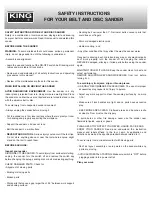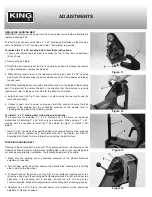
OPERATION
OPERATIONAL GUIDELINE FOR USING THIS BELT & DISC SANDER
WARNING!
FOR YOUR SAFETY AND TO REDUCE THE RISKS OF FIRE, THIS BELT & DISC SANDER SHOULD BE DEDICATED TO
SANDING ONLY ONE MATERIAL (WOOD OR
METAL). IF YOU DESIRE TO SAND WOOD AND METAL, IT IS EXTREMELY IMPORTANT THAT
THE SANDING BELT AND SANDING DISC HOUSINGS BE COMPLETELY CLEANED OF ALL WOOD DUST OR METAL DUST BEFORE
USING AGAIN. FAILURE TO RESPECT THIS WARNING COULD LEAD TO FIRE.
1. The workpiece should not contact the sanding belt or disc during a start-up. Allow the motor come up to speed before attempting to sand a
workpiece.
2. If you observe a wobble or runout. If the disc is not operating smoothly, stop the sander and have the machine serviced before using the sander
again.
3. Always sand on the side of the sanding disc that rotates downward. Sanding on the opposite side could cause the workpiece to slip and fly
out of your hands, creating a dangerous situation.
4. The disc and belt tables must be set a maximum of 1/16” away from the sanding disc or belt.
DISC
SANDING
Warning!
Always make sure the sander is unplugged prior to attempting any
installation or changing of parts and accessories.
When sanding, always position your workpiece (A) Fig.19 on the downward, rotating
side (right side) of the sanding disc as shown. Sanding on the left side of the
sanding disc, upward rotating side is dangerous, as your workpiece cannot be
controlled and ‘kick-back’ may occur - the wood being forced up and out of your hands.
Use the miter gauge (B) Fig.19 for added control of the work piece during sanding.
The miter gauge can also be set to various degree angles for maintaining accurate
angles when sanding small or multiple parts.
Do not force the work piece into the sanding disc. Sand using light pressure, move
your workpiece slightly left and right on the disc, keeping to the right-of-center,
downward side. This will help prevent resin or debris from building up on one area of
the disc, and also helps to prevent burning of the sanded surface from excessive abrasive-action heat build-up.
NOTE: It is strongly recommended to use a dust-collection system when using this belt & disc sander. Use of a dust mask or respirator is still
recommended, even when a dust collection system is in use.
BELT SANDING
Warning!
Always make sure the sander is unplugged prior to attempting any
installation or changing of parts and accessories.
Depending on what type of sanding that you will be doing, set the sanding belt table
to the proper angle using a square or a protractor.
Do not force the workpiece (A) Fig.20 into the sanding belt (B). Sand using light
pressure. Move your workpiece slightly left and right on the belt. This will help prevent
resin or debris from building up on one area of the belt, and also helps to prevent
burning of the sanded surface from excessive abrasive-action heat build-up.
The platen (C) Fig.20 supports the back of the sanding belt and offers a flat surface
to sand or sharpen against. It should be positioned so it is almost touching the back
of the sanding belt. To adjust the platen, loosen the cap screw (D) at the rear of the
platen. The platen can also be removed for contour sanding or polishing.
NOTE: It is strongly recommended to use a dust collection system when using this belt & disc sander. Use of a dust mask or respirator is still
recommended, even when a dust collection system is in use.
Figure 19
Figure 20






























